|
Toa Payoh
Vets Clinical Research
Making veterinary surgery alive
to a veterinary student studying in Australia
using real case studies and pictures |
Mouth Ulcers In Cats
Dr
Sing Kong Yuen, BVMS (Glasgow), MRCVS
Updated:
07 May, 2011
Case written: 05 October, 2002 |
 Toa
Payoh Vets Toa
Payoh Vets
Be Kind To Pets
Veterinary Education
Project 2010-0005 |
|
The drooling cat
|
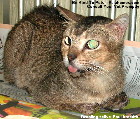 "This is a frightened cat,"
65-year-old Groomer Ken said as he lifted the
drooling cat out of the cage onto the examination
table. "The hair along the back stands on end. Her
ears are held up and back for protection. Her tail
is wrapped round her body to prevent injury. Her eye
pupils are dilated. Her body is arched and her
whiskers are pulled back. She drools." "This is a frightened cat,"
65-year-old Groomer Ken said as he lifted the
drooling cat out of the cage onto the examination
table. "The hair along the back stands on end. Her
ears are held up and back for protection. Her tail
is wrapped round her body to prevent injury. Her eye
pupils are dilated. Her body is arched and her
whiskers are pulled back. She drools."
Groomer Ken was right. This five-year-old spayed cat
was an indoor cat and had never left the condo. She
must be frightened of the smells of dogs and other
animals in the veterinary clinic. Singapore
does not have a cat-only veterinary clinic and
barking dogs at the clinic could also frighten
cats.
"Why is she drooling?" Nurse Ann asked me as viscous saliva oozed out
continually from her mouth, below the protruding tip
of a pink tongue. Gravity pulled down the drops onto
the examination table. The cat seemed unable to keep
her tongue inside her mouth as the tip of the tongue
dangled out.
Her front legs were stained with saliva and food
debris for some weeks and she could not groom
himself now. Ann was now used to the foul breadth of
cats and dogs and did not complain.
Ken said, "This cat must have a fish bone inside the
mouth or throat for the past two or three months.
She is now skin and bones because she cannot
masticate properly."
 Nurse Ann
asked, "What is 'masticate'? It sounds like an
obscene word!" Nurse Ann
asked, "What is 'masticate'? It sounds like an
obscene word!"
Ken expected Ann to know medical words as she was in
the veterinary profession. "It means chewing and
crushing the cat feed pellets to small pieces."
I said to Ken, "Singapore does not have a veterinary
nursing college. Therefore, it will take some time
for Nurse Ann to learn more about medical terms on
the job."
The cat pawed at me as she strongly objected to her
mouth being opened. She swung her right paw out at
my hand, claws unsheathed. Her hind legs were all
stretched out, ready to escape from Ken's iron
grip on the scruff of her neck.
She hissed and thrashed her tail from side to side
as if she was a snake trying to intimidate me. She
was now a fighting cat.
I boarded her after giving her an antibiotic
injection and dextrose saline as she was too weak to
be tranquilised for a proper examination of her
mouth.
In this case, a tranquiliser into her back muscle
would relieve the cat's of intense mouth pain. Then
I could examine her mouth without causing more
stress to the patient. What could be the cause of
drooling?
She was now very thin. Emaciated as if she was a
street cat with infectious diseases. She wanted to
eat but could not eat more than three pellets of cat
food. Her mouth was excruciatingly painful as the
food touched the tongue.
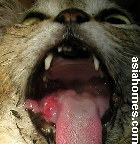 So, she would not eat much. So, she would not eat much.
The next day, she was feeling better. I
tranquilised her but she needed some gas anaesthesia
as her tongue was painful. She slept well when
given the gas anaesthetic and this was a good sign
that her pharynx was not obstructed.
White plaques covered the back of the tongue. I
could see a much larger rounded mass of tissue on
the right side of the back of the tongue. The left
side had a smaller lump. This would be the
adenoid tissue which is part of the cat's
tonsils.
This tissue filters out all the germs and toxic
substances - the bacteria, viruses and toxins from
entering the lungs and stomach. Like frontline
soldiers. Only that the tonsillar tissues were
overwhelmed. The tissues increased in size
and hardened. The cat could not swallow. Saliva
could not be swallowed too and the cat drooled.
Was there a fish bone lodged deep inside the growth?
The owner had said that the cat was given only dry
cat feed and no fish.
Was the cat
suffering from cancer of the tonsils? I
palpated the submandibular lymph nodes located at
angle of the jaws under the skin. The cat was now
anaesthesized by gas and she could be properly
examined. The nodes were hard and enlarged but not
considerably. A gritty feel as if the nodes had
sand.
The much enlarged tonsillar tissue areas were
hard lumps. They obstructed the entry into the
oesophagus by 50%. Ulcerated and painful. It was
difficult for the cat to swallow food. She only ate
dry feed pellets and the pain would be worse than if
she ate liquid food.
She did not even want to consider the crushed
powdery feed or the canned feed. It is not
easy nor the time to change her eating preference.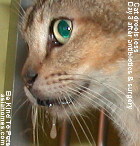
Should I cut off the lumps or wait for them to
reduce in size after antibiotic injections for the
next few days? Would the cat die if surgery
was done? If it was not done, the cat would drool
and the bad breadth would return in the next week.
It would cost the owner more money for further
treatment.
There is a limit to veterinary spending on the cat
as most Singapore owners do not wish to spend much
on a cat. Fees add up when there are laboratory
tests and repeat visits.
The cat had been given dextrose saline and
antibiotic injection twenty four hours before
tranquiliser and anaesthesia to make her stronger.
Surgery to remove the enlarged tonsillar tissues
might cause bleeding. The bacteria and fungal
micro-organisms that populated in large numbers in
her mouth would then spread all over the body
through the blood stream.
This might be the only opportunity for this cat to
get cured as many time-pressed Singapore cat owners
don't return for repeat visits. A reluctance to
spend money could be a reason.
I cut off the top part of the lump.
There was little bleeding. The cat recovered in the next three days
and she meowed to greet me. There was some drooling from the right
side for the first two days. The tongue no longer prolapsed out.
The cat would not want to eat the crushed powdery pellets. She just looked
at them and smelled them but no, she was not going to eat such powdery stuff
which I thought would be appropriate since she had a sore throat and could
not swallow well. She was able to groom herself after Ken
bathed her and scrubbed all her dirty stains on the front legs at the end of
anaesthesia.
 On the third day, I gave her the dry
pellets on the floor of the cage as she would not eat canned feed nor the
powdery pellets. On the third day, I gave her the dry
pellets on the floor of the cage as she would not eat canned feed nor the
powdery pellets.
Nowadays, the pet companies sell small packets of meat cubes in gravy so
that there was no need to buy a big can. The cubes looked appetising to me
but this cat was not interested. She was really hungry and ate very fast.
Suddenly she made a gagging sound as she choked and felt the pain in the
back of the mouth. She recovered quickly. She choked another time as
she swallowed too fast.
 "She is as thin as ever for the last
four years and friends think I mis-treat my cat," the owner complained to me
when I asked about the cat's feeding habits. "She is as thin as ever for the last
four years and friends think I mis-treat my cat," the owner complained to me
when I asked about the cat's feeding habits.
He and his wife had bought all kinds of feed, consulted a vet and had given
deworming medicine. But the cat was still as thin as a rake. Could it
be due to the fact that this cat would not eat sufficient amounts.
This condition happens to pre-teen girls and boys in affluent families in
Singapore too. They just do not eat much and are very fussy with the kind of
food they will eat. Doctors will diagnose as nothing wrong with them.
The bacterial infections in her mouth produced toxins. These toxins spread
via the blood and now had affected her whole body system. She became toxic
and lost her appetite. It was a surprise that she was still alive. The cause
of his tonsillitis was unknown but the mouth ulcerations could be due toxic
substances.
Antibiotics did reduce the infections in her swollen tonsils and her
submandibular lymph nodes were less gritty when checked 7 days later. There
was a little drooling even after ten days. However the cat could eat
her pellets.
Why did this cat drool? Many questions have no answers. One
possible cause of this tonsil infection could be the environment. The cat
was the only one of the three that loved to sleep in the place where the dog
passed his excrement and urine.
Over the months, the waste products of the dog could have contaminated this
cat and she could be licking off the toxic products during grooming. In
time, the tonsils just could not cope and enlarged much more. Bacteria and
fungal infections came in and cause ulcerations and mouth infections known
as stomatitis. The solution might be simple - remove the cat
from the area.
There could be other causes such as autoimmune diseases where the cat's
immune system had produced antibodies to attack its tonsils. Or a cat virus
such as herpes virus could be present although there were no signs of runny
nose or lung diseases. This cat did not suffer from the usual chronic
gingivitis or inflammation and infection of the gums as her teeth and gums
were in good condition.
Two weeks after going home, the cat drooled again. If there was no cure, it
would be euthanasia for this cat.
This was the real world in which there was a limit to the amount of
veterinary fees, laboratory tests for viral infections and drug costs to be
paid by a cat owner. Singapore just had an increase in bus fares. Now, the
medical and hospitalisation charges for people would be increased soon.
Therefore, the cat would be euthanased if there was no guarantee of
success.
The lower part of her gums on both sides were blood red and swollen around
the teeth. An anti-inflammatory injection was given in the muscles. An
antibiotic injection was given under the skin. There was no drooling
the next day and the cat continued eating. Drooling stopped for the next 14
days.
The swollen tissues had shrunk. The cat
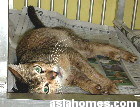 meowed when she saw Nurse Ann
and groomed herself well. She liked to rub her face against the cage bars to
mark her territory. She ate the dry feed well and had gained weight. meowed when she saw Nurse Ann
and groomed herself well. She liked to rub her face against the cage bars to
mark her territory. She ate the dry feed well and had gained weight.
This was most likely an auto immune disease. Fortunately, the cat did
not suffer from oral tumours. The swollen tonsillar tissues would reduce
after treatment. There was no complaint from the owner for the next sixty
days. The cat's tongue no longer protrude from the mouth. It was great to
see her back to normal.
The tissues from the tonsils could be sent for laboratory examination for
tumour but in private practice. However, the cat owner would like minimal
veterinary costs and so this was not done.
A few follow-ups with your vet if your cat has oral problems are
essential if you want the cat to live longer lives. One visit to the
veterinarian is not sufficient. Seek a second opinion but it is
obviously better to work with one veterinarian rather than doctor-hopping as
the progress of the disease can be monitored by your first veterinarian.
Sadly, many Singaporean owners either do not have the time nor knowledge to
follow up in time as in this case. Surprising this cat, though emaciated,
could survive the tranquilisation and anesthesia without dying, as she was a
very high anaesthetic risk.
Owners never forgive the veterinarian if the cat dies under anaesthesia.
They never forget if they forgive and seldom want to consult the vet again.
Sometimes they bad-mouth the veterinarian to their friends. This is the real
world!
REFERENCES:
1. A well researched
reference by a cat lover:
Steatites in the Cat & useful references (the hyperlink to Geocities
is dead. The webpage is published below. Geocities has closed down and so
the link has been archived somewhere.).
2. RABIES IN CATS:
Singapore does not have rabies for more than 50 years. The U.S State law
requires any animal that is suspected of rabies to be quarantined for 10
days. Rabies symptoms are usually manifested within 4 days after infection.
The animal, if infected, usually dies within 10 - 12 days.
An infected cat will have clinical signs that are divided into three phases.
The first 2-3 days post exposure there will be mild behavioral changes that
may go unnoticed. A mild fever, dilation of the eyes, and extreme pain
around the bite wound will usually be present. The next phase is known as
the "furious phase". For 2-5 days cats will be excitable, aggressive and may
attack without any provocation.
Staggering, salivation and muscle tremors may also be present during
this phase. The last phase is known as the paralytic phase and lasts only a
few days until the cat dies. For the final 2-4 days of the infection, the
cat may seizure, a general paralysis will overtake the feline and death will
occur after the patient falls into a coma.
Diagnosis is based on clinical signs and a special IFA test performed on
brain tissue from the dead animal. If a cat bites a human, it will be
quarantined for about 10 days for observation. If no signs are present, all
involved can rest easily. Cats showing clinical symptoms or animals
otherwise killed after a bite must have their brain examined by this Immuno-fluorescent
antibody test for rabies.
3. RODENT ULCERS IN CATS
(feline eosinophilic granulomatosis). Salivation and ulcers are signs.
Eosinophilic Granuloma Complex -
Three distinct but related clinical syndromes comprise the granuloma
complex:
3.1 Eosinophilic (or rodent) Ulcer. This may occur on the skin or in
the mouth but usually affects the upper lips. The lesions are
well-demarcated ulcers.
3.2 Eosinophilic Plaque. These are raised, moist, red eroded or
ulcerated areas with a well demarcated border. Pruritus is usually severe.
lesions usually occur on the underside of the cat (abdomen, brisket or
inside the thighs.)
3.3 Linear Granulomata. These can occur at most sites, especially
behind the hind legs and within the mouth. They are well-demarcated lesions
which are raised and yellow to
yellowish-pink in colour. They are often thin, hence the name *linear*
granuloma.
The mechanisms leading to the onset of this group of symptoms is unclear.
However it is known that cats with flea allergy, food allergy or atopic
dermatitis may have ECG. It is probable that the underlying causes of ECG
are similar to those of Miliary Dermatitis (Parasites, Hypersensitivity,
Infections and Essential Fatty Acid deficiency).
Treatment is based on identification of the underlying cause or the use of
anti-inflammatory drugs (gluco-corticoids, essential fatty acids and
anti-histamines) in undiagnosed cases.
|
432. Blog: A cat owner's
cat mouth ulcers posting in Geocities
Steatites in the Cat & useful references |
|
Geocities webpages are no
more. The following detailed website of cat mouth ulcers was
previously published by a cat owner. After Geocities closed
down, the webpage was gone. I managed to track it down to an
archive and publish here for references
Boot's Story:
Lymphocytic-Plasmacytic Stomatitis.
Feline Viruses, Auto Immune Diseases
& Interferon
"You Are The Wind Beneath My Wings"
from the movie Beaches
Sept 1996. Boots, shortly after he came home with us.
Weighing about 7 lbs, and waiting for his boiled chicken.
Lymphocytic plasmacytic stomatitis (LPS) is thought to be an
auto immune disease of the gums and lining of the mouth and
throat, although the exact cause is unknown. It can only be
confirmed through biopsy. Although the symptoms may appear
the same, do not mistake this disease with chronic
gingivitis which is almost always due to tartar buildup.
The first thing to understand about this condition is that
this disease is generally a secondary symptom of a greater
underlying viral infection such as Feline Immunodeficiency
Virus, Feline Leukemia, Feline Herpes (aka Rhinotracheitis)
or Calicivirus. Always, always have your kitty tested for
FeLV and FIV if faced with this condition. Fortunately Boots
tested negative, both at the shelter, and by our own
veterinarian, however our vet did conclude that Boots was
chronically infected with Feline Herpes.
These viruses may cause other symptoms besides the
stomatitis. You may notice your cat is more susceptible to
upper respiratory infections and eye problems. As this
condition is also thought to be associated with auto immune
deficiency, you are also dealing with a disease that is
triggered by stress. The stress of being in a shelter for
two years had eroded Boots' mouth and gums to the point
where he couldn't swallow. He weighed seven pounds when we
brought him home in August of 1996.
The single biggest thing we have found to make a difference
in the management of this disease is Interferon, an
anti-viral medication developed for use in humans. We now
have three years experience with it, and we have seen a
dramatic improvement with Boots.
Boots' stomatitis was very severe with involvement down the
throat and into the larynx and the loss of 3 teeth, but we
have managed to stabilize it to the point where he's now
eating boiled chicken (spoiled cat) and has almost doubled
his weight since we began this protocol.
Our initial routine with him was teeth and gum cleaning and
cortisone if necessary every 3 months, Antirobe
(Clindamycin) antibiotic 1 cc X2 daily, and 1 cc of diluted
(30 units per 1 cc of sterile water) Interferon a day.
Cortisone (Depo-Medrol) is also common therapy for this
disease. But you want to try to minimize the amount you have
to give as it has long term side effects. Used judiciously
it helps to control the inflammation and pain. Some cats
require cortisone on a monthly basis, however we have found
that the Interferon has significantly reduced the progress
of the disease, therefore we are giving it less often. Our
doctor mixes the Interferon in the correct diluted dosage
and freezes it in 10 cc syringes. Interferon has a very
short shelf life and cannot be kept in the refrigerator over
an extended period of time. We thaw one syringe and use it
for 10 days. It is given orally, and is mostly water, so
there's no taste. You can either syringe it directly into
the mouth or mix it into food.
Regular teeth cleaning is necessary to control tartar
buildup which can make the mouth and gum ulcers worse and
also open the body up to serious infection, so its important
that you monitor this closely.
Interferon is a drug that was originally developed for human
cancer intervention, and is also being used in human AIDS
treatment. It is the only known anti-viral medication
mankind has developed. It has mixed success in humans, but
veterinarians are having greater success with cats.
Consequently it is being used to treat or manage many feline
viral infections including Calicivirus, herpes (both of
which have stomatitis as a complication), Feline Leukemia,
Feline Immunodeficiency Virus and even Feline Infectious
Peritonitis.
If all else fails, removal of all the back teeth seems to
provide relief. While this might seem extreme, cats can do
very, very well without teeth as long as you feed them
canned food, and the quality of their lives can be
excellent.
I was reluctant to take home a sick cat, so soon after
having lost my beautiful Tardy. But Boots caught my eye, and
I know without a doubt it was Tardy who had pointed him in
my direction. Boots was so pathetic looking, scrawny and
haggard. I knew the wonderful volunteers at the shelter were
doing everything they could to help him, but I also knew
Boots was slowly failing, and that he would be hard to
place. I couldn't leave him there, even though I thought at
the time I was opening my heart to eventual grief. The
shelter had been very, very careful to be sure I understood
this was a lifetime problem. I took him on a foster basis,
not yet ready to deal with what I thought was a terminal
illness which would lead me to more grief. But after the
first few hours of having him in a real home and watching
him bound delightedly from empty room to empty room, I knew
Boots was home, and I called to say he wasn't leaving. The
shelter waved the adoption fee.
Not knowing anything about stomatitis, I had no idea how
much could be done to manage this disease. Two years later
Boots now weighs over 14 lbs. He purrs now, and he plays
with the other cats. He rules the house. I know that God and
my rainbow Tardy are watching over us, but I also know the
real difference in these animal's lives has been the
experience and the unbelievable knowledge of our vet. It has
been the deciding factor in our ability to maintain their
health.
If, for any reason you feel that your vet isn't dealing with
this properly, I urge you to seek a second opinion. The key
to our success lay in the fact that our doctor keeps up with
current trends, and with the published literature, and we
are the beneficiaries of his dedication to his profession.
I leave you with one final thought. Don't lose hope! Boots
has taught me that although you might face the pain of
losing an animal, it is always worth the risk to open up
your heart, to love and to try. The reward is indescribable.
I often wake up in the middle of the night to find Boots
nuzzled against my face, purring.
Below you will find a number of links I have collected
regarding Stomatitis, Viral diseases for which stomatitis is
an opportunistic symptom, and some info on Interferon. If
you have any more questions, or comments never hesitate to
e-mail me.
Boots today, at 15 lbs, healthy and happy.
Postscript: I have always believed that Tardy led us to
Boots. On June 4, 1997 I finally trapped and took in a stray
that had been visiting us for several weeks. The first thing
our doctor did was look at his mouth. We now have two cats
with this disease, and two cats who are thriving because of
our vet's skill and Interferon. Sammy lives indoors with us
now, and Tardy watches over us still.
September, 1999 Update: Boots continues to thrive. He is
still on 30 units of Interferon daily and has been since
August, 1996. Just recently I received an unexpected e-mail
from the wonderful woman who worked with us on adopting
Boots. One of her shelter co-workers had found Boots' Story
on the web and printed out the information to help with one
of their shelter cats. Jo sent me an e-mail asking if this
was possibly the same Boots. We traded e-mails, and finally
Jo came to visit us. I was so proud to show her how well he
is doing, and we both shed a few tears of happiness. Life
takes unexpected turns, and it is so fulfilling to have a
circle completed.
November, 1999 Update: Sammy has developed a Herpes eye
infection. We are treating it with two human Herpes
medications - Viroptic and Chloroptic eyedrops 4 times a
day, and 250 moms of L-lysine amino acid twice a day. The
Viroptic drops seem to sting, so I give him the Chloroptic
drops first to water down the Viroptic side effect. This
seems to work. After 4 weeks, the medication is having a
noticeable effect. There is no more squinting and Sammy
seems to have regained all his old habits and appears to
feel no more discomfort.
February 28, 2000: Our vet has just returned from a
conference and is hearing wonderful things about L-lysine
and viral infections. I have continued Sammy on 250 mgms of
L-lysine twice a day since his Herpes eye infection, even
though that has resolved. I am convinced it is helping him
stave off URI's when we take vet trips. Today our vet
recommended we begin Boots on the same dosage.
Stomatitis Links
About Stomatitis:
Feline Stomatitis - site includes good photos of what this
condition looks like.
Oral Ulcerations - Includes diagnostic procedures and drugs
of choice for treatment
Feline Stomatitis - More on Stomatitis from Dental Vet
Mouth Problems in the Cat - from the Feline Advisory Board
in the UK
Stomatitis - From the Cat Fancier's Association
Veterinary Dental Care & Problems of the Mouth
Understanding Your Pet's Immune System - a good basic
explanation of how the immune system works. Warning! Its a
little technical!!
About Herpes and Calici Viruses:
Feline Herpes Virus - A veterinarian's explanation.
Herpes Virus, Stomatitis and Interferon - Dr. Mike Richards
continues with an explanation of treatment
Herpes Virus: Symptoms and Treatment - Another good
explanation of the relationship between Herpes and
stomatitis.
Use of Interferon in Feline Herpetic Keratitis - corneal
ulcers are another complication of Herpes virus
Calici Virus, Upper Respiratory Infections & Mouth Ulcers -
Not so common a virus, but complications can include
stomatitis. Excellent info on dealing with Chronic
Reparatory problems!
Chronic Nasal Disease - Causes and Treatment
Upper Respiratory Infections - What to do when Kitty has a
cold
Cat Colds - Causes and Treatment
About Interferon and its use in treating other viruses:
Interferon and FeLV / FIV - Using Interferon to combat
leukemia & immunodeficiency viruses.
Newer Methods for Treating FeLV - Includes a link to an
company manufacturing Interferon, and protocols for use.
Smudge's Story - Smudge has Feline Leukemia, and he is truly
an Interferon success story.
Chloe's Story - An excellent site for info on FeLV,
including Interferon treatment.
Dr. Mike Richards - using Interferon for FeLV
Dr. Richard C. Weiss - developer of the FeLV vaccine. A list
of published articles on the use of Interferon in treating
FeLV
Colorado State University - Study on the use of Interferon
in treating FeLV
Living with the FeLV+ or FIV+ Cat. - How viruses affect the
cat, False Positives, Treatment, Information and Support.
See the treatment section.
Pyewacket's Story - FIV and Interferon. A genuine success
story.
Felix's Story: FIV and Interferon
FIP and Interferon - The use of Interferon in managing
Feline Infectious Peritonitis
What is Interferon? - This site is for Human Hepatitis, but
does a good job of explaining how Interferon works.
Interferon: Patent claims
Resources:
Dr. Camuti Memorial Feline Consultation & Diagnostic Service
- a wonderful resource for either you or your vet. For a $35
consultation fee you can talk to a vet at Cornell about
diagnosis, treatment and the protocols involving Interferon.
|
|
|
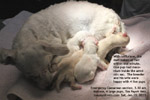
For other small animal cases, goto
Dogs |
 Toa
Payoh Vets Toa
Payoh Vets
Be Kind To Pets
Veterinary Education
Project 2010-0005 |
|
|
|
|
|
Copyright ©
Asiahomes Internet
All rights reserved. Revised: May 07, 2011
Toa Payoh Vets
|
|
 TOA
PAYOH VETS
TOA
PAYOH VETS TOA
PAYOH VETS
TOA
PAYOH VETS